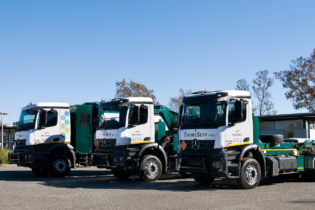 3D printing has been taken to the next level by Mercedes-Benz Trucks. The company has produced its first printed spare part made of metal.
3D printing has been taken to the next level by Mercedes-Benz Trucks. The company has produced its first printed spare part made of metal.
The part – a thermostat cover for truck and Unimog models from older model series – has passed all the stages of the stringent quality assurance process.
Mercedes-Benz Trucks believes that with this advancement the company is now the technological leader in the challenging segment of cutting-edge 3D printing processes for metal components.
“With the introduction of 3D metal printing technology, Mercedes-Benz Trucks is reasserting its pioneering role among global commercial vehicle manufacturers,” says Andreas Deuschle, Head of Marketing & Operations in Customer Services & Parts at Mercedes-Benz Trucks.
“We ensure the same functionality, reliability, durability and cost-effectiveness with 3D metal parts as we do with conventionally produced parts.”
In the Customer Services & Parts division of Mercedes-Benz Trucks, automotive 3D printing began its increasing success in the production departments for the after-sales and replacement parts business a year ago. Since then, Customer Services & Parts has worked together with the researchers and pre-developers at Daimler AG to constantly improve and expand the use of the latest 3D printing processes for plastic parts. 3D printing of high-quality plastic components has now successfully established itself as an additional production method, and is particularly suitable for the production of smaller batches.
Opening up new possibilities
Metal parts from the 3D printer excel with their very high strength and thermal resistance, and the process is therefore particularly suitable for the production of mechanically and thermally stressed components required in small numbers.
Metallic components can be produced at the touch of a button with any geometry and in any numbers.
Conceivable areas of use are peripheral engine parts made of metal, in-engine parts and also parts in cooling systems, transmissions, axles or chassis. Especially when they have complex structures, 3D-printed metal parts in small numbers can be produced cost-effectively as infrequently requested replacement parts, special parts and for small and classic model series.
“The availability of spare parts during a workshop visit is essential for our customers – no matter how old the truck is, or where it is located. The particular added value of 3D printing technology is that it considerably increases speed and flexibility, especially when producing spare and special parts.
“This gives us completely new possibilities for offering our customers spare parts rapidly and at attractive prices, even long after series production has ceased,” Deuschle concludes.
In the future, 3D metal printing might allow decentralised and therefore much faster, local production directly in the worldwide Mercedes-Benz production locations. This would further improve parts availability: expensive warehousing and the associated, complex transport processes would be unnecessary, with delivery times made shorter for customers.
Rapid global availability
The new thermostat cover is an example of cost-effective spare and special parts production in top quality, made possible by use of the 3D printing process for highly resistant metal parts made of die-cast aluminium alloy.
This replacement part is only ordered in small numbers, and is used in older truck and Unimog models whose production ceased around 15 years ago. This example shows that Customer Services & Parts is able to produce and offer components that are no longer installed in current series production vehicles, or are only produced in very small batches as special customer requests, at a reasonable cost.
Thanks to advancing digitisation, even highly specific metal components can be ordered from Mercedes-Benz Trucks and delivered anywhere in the world on request, even after many years: quickly, cost-effectively, in requisite numbers and in consistently high OEM quality.
 3D printing has been taken to the next level by Mercedes-Benz Trucks. The company has produced its first printed spare part made of metal.
3D printing has been taken to the next level by Mercedes-Benz Trucks. The company has produced its first printed spare part made of metal.







